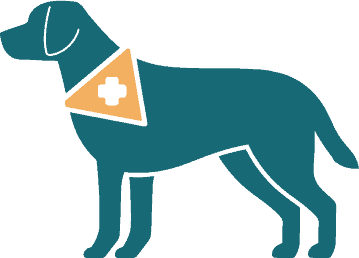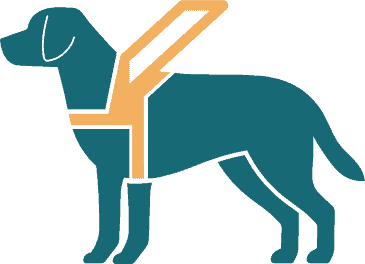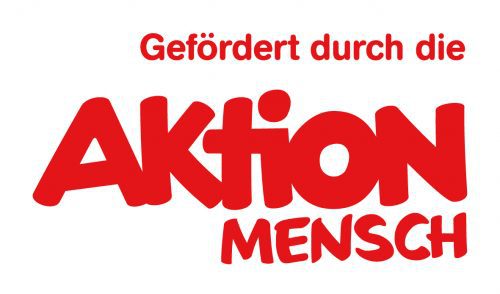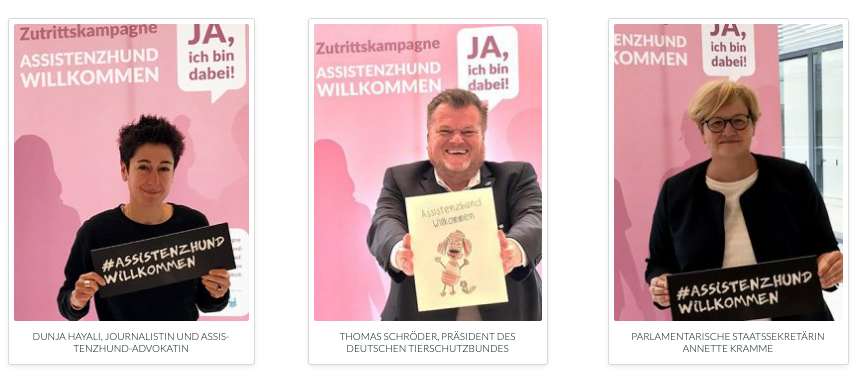About assistance dog teams
What they do, what they need, their rights

Who are assistance dogs?
Assistance dogs are specifically trained to assist an individual living with one or multiple disabilities in their everyday life.
They undergo long and intensive training and then live permanently with their human partner. By providing such assistance, they enable a more mobile and self-determined life.
Many people are familiar with guide dogs for the blind, but there are many other types of assistance dog who are no less important and growing increasingly common.
Here are some of the common types of assistance dogs:
Visual impairment
guide around obstacles
Alert to both dangers and destinations
Hearing impairment
Display sounds
Warn of dangers
Retrieve lost items
Limited mobility
Retrieve objects
Operate doors/switches
Assist with undressing
Support balance
Epilepsy, narcolepsy, etc.
Alert to crises, get help
Retrieve medication
Protect and soothe
Post Traumatic Stress Disorder (PTSD)
Interrupt crises
Awaken from nightmares
Relieve sensory overload
Autism/FASD
Relieve sensory overload
Support routines
Diabetes, allergies
Detect allergens
Alert to crises at an early stage



How can I recognize assistance dogs?
Assistance dogs generally wear this equipment while working:

Neckerchief

Harness

Vest
Correct behavior around assistance dog teams

Even if you have many questions and perhaps a dog treat in your pocket – please pay attention to these rules of conduct and safety instructions:
- Do not distract an assistance dog by stroking them without their human’s permission.
- Do not stare at the team – this can be unpleasant for both dog and human!
- Do not speak to the dog and do not lure them.
- Do not feed the dog.

Make it easy for an assistance dog team to continue their day undisturbed and safely:
- Make sure you give them as much space as possible.
- Keep your distance with your dog when an assistance dog is working and/or on a lead.
- Please also keep your dog on a lead.
- It’s fine to talk to the person, but avoid personal questions like “Why do you have an assistance dog”?

Access rights of assistance dog teams

An assistance dog is more than “just” a companion dog. They enable their human partner to participate in everyday life. That is why assistance dog teams have access rights wherever people in street clothes are allowed.
The right to “animal assistance” is enshrined in international law (UN Commission on the Rights of Persons with Disabilities/UN CRPD).
In Germany, Section 12e (3) of the Disability Equality Act (BGG) protects tested teams from exclusion and discrimination.
Only healthy, well-balanced, and reliable dogs can cope with the demanding training so no problems can be expected from assistance dogs. As assistance dogs, they have the right of access to public places worldwide.
Hygiene? No problem!
Assistance dog teams are welcome wherever people in street clothes are welcome. This means that assistance dogs are also allowed in grocery stores, restaurants, cultural institutions, and in the medical sector. A ban on dogs does not affect them because they are not “dogs” but also fall under the umbrella of medical aids.


Assistance dog team test iCert360™ of the Assistance Dog Foundation
Regardless of whether you have trained your assistance dog yourself, acquired them from an assistance dog school or financed them yourself: all assistance dog owners benefit from an independent team assessment. It guarantees quality and meets clear standards.
The Assistance Dog Foundation, which was founded by Pfotenpiloten in 2020, offers such an independent assistance dog team test.
iCert360™ documents the inspection from several perspectives using 360-degree cameras. Independent experts review these videos and provide a test certificate and recommendations for the team.

Our label stands for a tested and cooperative assistance dog team worldwide. It will be available from mid-2024 for assistance dog teams tested by us, as well as those with a comparable test.
DogMap: find and mark (assistance) dog-friendly places

Using the interactive DogMap, dog lovers worldwide can mark places with All dogs allowed, Only assistance dogs allowed or Access barrier.
In the profile of a location, Google’s information can be supplemented with your own comments on dog-friendliness.
It’s easy to book a vacation, plan a day out with your dog, and discover a new favorite place.
DogMap is forever free and growing rapidly. With nearly 500,000 entries, the DogMap app can be found on many dog owners’ cell phones, and is building an important community to promote assistance dog teams.

Assistance dog-friendly community campaign
Pfotenpiloten, the german organization behind DogMap, has been opening doors since 2018 through the “Assistance Dog Welcome” access campaign on behalf of the German government. Since its completion, we have been making entire communities assistance dog-friendly with funding from Aktion Mensch!
Almost 100 municipalities across Germany have already set out on this journey!
Have a look at who is already taking part and then ask your home town whether they would like to be involved.




About Pfotenpiloten and the Assistance Dog Foundation

Since 2015, Pfotenpiloten has been committed to ensuring that people with disabilities can start a more mobile life with a well-trained assistance dog.
We do not train assistance dog teams: Instead, as an independent non-profit organization, we create effective structures for training, quality, standards and promotion. In addition to various access campaigns, our work also includes the DogMap, an EU project for assistance dog trainers, participation in the EU standard “Assistance Dogs” and political lobbying.

Assistance Dog Foundation creates strong, reliable structures for quality assurance, recognition, and support. Like the parent organization, Pfotenpiloten, our independence determines our work. We do not train assistance dogs, but focus on sustainable solutions that consider the interests of all parties involved – owners, dogs, trainers, the public, and sponsors.
We are convinced that a sustainable concept can only develop if everyone’s needs are considered.

